Everything You Need to Know About Biometric Authentication
Digital Technologies are transforming the business landscape enabling new ways of doing business and enhancing marketing processes through automation to reach the right customers. But we cannot overlook the fact that cyber crime is also on the rise exponentially and this evolving technological age has provided a fertile ground for fraudsters to exploit and compromise the privacy of individuals and organizations alike. As we embrace new technological solutions to improve efficiency and convenience, we must also be proactive in safeguarding against cyber threats. Implementing security measures such as Single Sign On (SSO), Multi-Factor Authentication (MFA), Biometric Authentication, and more have become paramount to mitigate the risks posed by cyber criminals.
In recent years, biometric authentication has become increasingly popular in various industries, including banking, fintech, healthcare, etc. This security method can effectively secure both on-premise and cloud infrastructures of businesses of different scales, from SMBs to large enterprises.
What is Biometric Authentication?
Biometric authentication is a method of identity verification that uses unique physical characteristics of individuals known as biometric data, such as fingerprints, facial recognition, voice recognition, etc., to verify the identity of an individual. For banks, fintech, and healthcare businesses, this technology offers a more secure and convenient way to authenticate customers and protect against fraud. Banks and fintech companies can ensure that their sensitive information and funds are safe and also their customer’s accounts are protected against cyber attacks.
A healthcare organization can ensure that the privacy of their patients is safe and also ensure that a fraudster doesn’t break into confidential patient information. Most banking apps and fintech apps require customers to log in through biometric authentication like fingerprint authentication, facial recognition, etc. It is also popularly used with Multi-factor Authentication, where biometric verification can be one of the 2FA factors for authentication.
What is Biometric Data?
Biometric data refers to any information related to a person’s physical, behavioral, and biological characteristics that can be used for identification purposes. This can include measurements or features such as fingerprints, facial recognition, iris scans, voiceprints, and even behavioral biometrics like gait or body posture.
Biometric data is often used in security systems, access control, or identity verification. It is considered more secure than traditional methods such as passwords or PINs, as it is unique to each individual and cannot be easily replicated or stolen.
However, the use of biometric data raises concerns about privacy and security, as it can be vulnerable to hacking, data breaches, and unauthorized access. Therefore, it is important to have proper safeguards and regulations in place to protect biometric data.
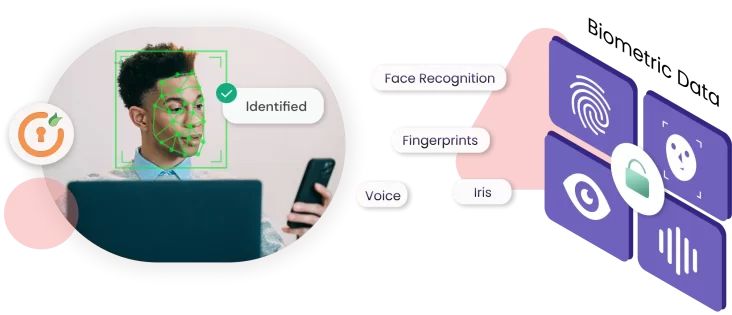
What is a Biometric Authentication Device?
A biometric authentication device is an instrument that records or aids in the recording of biometric data and also facilitates biometric authentication based on the recorded data. This device does both the job of recording and also using that data for biometric verification of the user identity. Biometric authentication devices are becoming increasingly popular in many industries as they offer a more secure and convenient way to authenticate a user’s identity compared to traditional methods like passwords or PINs. Most of these biometric authentication devices are lightweight and easy to use. Without these devices biometric authentication will not be possible, hence, these devices are the essential components that make the magic of biometric authentication possible.
Some examples of biometric authentication devices include:
- Fingerprint scanners: These devices use a person’s unique fingerprint to authenticate their identity. The user places their finger on the scanner and the device compares the fingerprint to a stored database of authorized fingerprints.
- Facial recognition systems: These devices use advanced algorithms to recognize a person’s face and compare it to a stored database of authorized faces.
- Iris scanners: These devices use the unique pattern of a person’s iris to authenticate their identity.
- Voice recognition systems: These devices analyze the unique characteristics of a person’s voice to authenticate their identity.
Apart from these examples, there are many different types of biometric authentication devices that can collect various types of physical and behavioral biometrics. This provides a more secure and convenient way to authenticate a person’s identity and is increasingly being used in various industries, including banking, healthcare, and government.

How does Biometric Authentication Work?
Biometric authentication is a process that uses biometric data and a biometric authentication device to verify the identity of an individual. The individual’s biometric data is collected through a biometric verification or authentication device. This can include facial recognition, fingerprint scans, iris scans, voice prints, or behavioral biometrics such as gait analysis. Then the collected biometric data is converted to a digital format that can be digitally stored in a database or directory and compared against future authentication attempts.
The digital biometric data needs to be stored in a secure database that can only be accessed by authorized personnel. Otherwise, biometric data is very sensitive and prone to getting hacked or stolen by cybercriminals and fraudsters. When the individual attempts to authenticate their identity, their biometric data is collected again and compared to the stored data in the secure database. If there is a match, the individual is granted access.
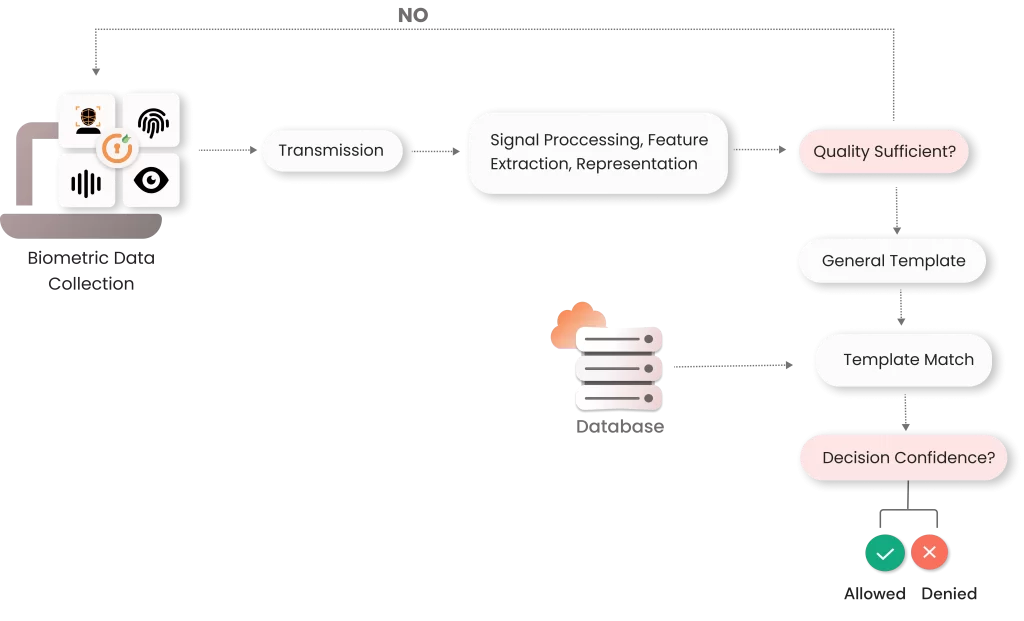
Biometric authentication can provide a high level of security as biometric data is unique to each individual and difficult to fake or replicate. However, it is important to ensure that the collection, storage, and processing of biometric data are secure and compliant with privacy regulations to protect individuals’ privacy and prevent potential data breaches. That’s Why miniOrange also provides secure directory services like Universal Directory in their suite of Identity & Access Management (IAM) services.
Types of Biometric Authentication
There are many types of biometric authentication methods, and these can be broadly classified into Physical and Behavioral Biometric Authentication.
Physical Biometric Authentication
This refers to using a person’s physical characteristics to verify their identity. Here are some types of physical biometric verification:
- Fingerprint recognition: The unique ridges and valleys on a person’s fingertips are used to verify their identity.
- Iris recognition: This technology uses the unique patterns of the iris, the colored part of the eye, to verify a person’s identity.
- Retina recognition: The unique patterns of blood vessels in the retina at the back of the eye are recorded and used for verification of a person’s identity.
- Face recognition: This method uses the unique features of a person’s face, such as the distance between the eyes, nose, and mouth, to authenticate their identity.
- Palm print recognition: The patterns of lines, ridges, and creases on a person’s palm are used to authenticate their identity.
- Hand geometry recognition: This method uses the shape and size of a person’s hand, including the length and width of fingers, to authenticate their identity.
- Vein recognition: This authentication method uses the patterns of veins in a person’s hand or finger to verify their identity.
- DNA recognition: A person’s DNA is used to verify their identity, but this method of authentication is still in the early stages of development and is not widely used.
Behavioral Biometric Authentication
This method uses behavioral biometrics (which are the unique patterns of human behavior) to verify a person’s identity. Here are some types of behavioral biometric verification:
- Keystroke dynamics: This involves analyzing the unique typing rhythm and patterns of an individual while typing on a keyboard.
- Mouse dynamics: The unique movement patterns and speed of the mouse while using a computer are analyzed and used for authentication.
- Signature analysis: This authentication method uses the analysis of the unique pattern of a person’s signature.
- Voice recognition: The unique pattern of a person’s voice, including pitch, tone, and cadence is used for this authentication method.
- Gait analysis: Gait is the unique way a person walks or moves, including stride length, speed, and other gait parameters. These gait patterns are used for the authentication of the individual in this method.
- Eye tracking: This involves analyzing the unique pattern of eye movements, including the duration of fixations and the speed of saccades.
- Touch dynamics: As the name suggests, the touch dynamic method uses the unique way a person interacts with touchscreens, including pressure, timing, and location of the touch.
- Behavioral profiling: In this method, the unique patterns of an individual’s behavior, such as browsing habits or application usage, are recorded to create a behavioral profile. This profile is used to authenticate individual users. The behavioral profile is also used in Adaptive Authentication methods.
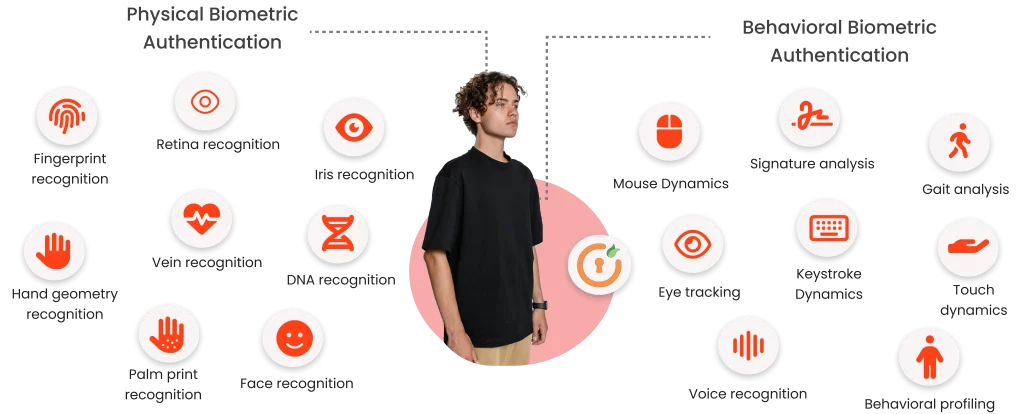
What are the Benefits of Biometric Authentication?
Today hackers, fraudsters, and cyber criminals have access to advanced technology using which they can easily steal credentials, decrypt encryptions, and break into VPNs which makes individuals and businesses more vulnerable to cyber-attacks. This is where biometric authentication can be a game changer. It is a powerful Multi-Factor authentication method that can help individuals and businesses protect themselves against cyber threats, and safeguard their customers’ sensitive information. Here are some of the key benefits of this authentication method:
- Passwordless Solution: Biometric authentication eliminates the need for passwords, and since biometric data is exclusive to each individual, it is virtually impossible for hackers to replicate or steal them. This eradicates the issues of weak passwords and password theft.
- Identity Theft Prevention: Identity theft can have serious consequences for businesses and can be prevented by verifying a person’s identity based on unique physical characteristics also known as biometric data such as fingerprints, facial recognition, voice recognition, behavioral biometrics, etc.
- Data Protection: The constant threat of sensitive data breaches can be eradicated with Biometric authentication which provides an additional layer of security that is difficult for hackers to bypass.
- Prevents Fraud: By verifying a person’s identity based on unique physical or behavioral characteristics, banks, fintech organizations, and other businesses can reduce the risk of fraud and improve overall security.
- Insider Threats Prevention: Employees often become the weak link in matters of security for organizations. Biometric authentication can help prevent insider threats by ensuring that only authorized personnel have access to sensitive data.
Why Should Banks, Fintech & Healthcare Organizations Consider Biometric Authentication?
The major threat banks, fintech & healthcare organizations face is an attack on their customer’s identity or login credentials using which cyber criminals hack their accounts to steal funds and sensitive data. Due to this, these organizations are faced with huge losses.
Biometric authentication is a method of authentication that uses unique physical and behavioral attributes to confirm the identity of the user, and since these attributes are unique to individuals, hence, it makes it difficult for cyber criminals to hack the user accounts. It is commonly used as one of the authentication factors for multi-factor authentication and it also makes MFA login more secure. There are several reasons why these organizations should consider MFA with biometric authentication as one of the 2FA factors for verifying their customers’ identities:
- Stronger Security: Biometric authentication provides a higher level of security than traditional methods such as passwords and PINs. Biometric data such as fingerprints, facial recognition, or voice recognition are unique to each individual and cannot be easily replicated or stolen.
- Convenience: This is a convenient and fast way for customers to access their accounts. They no longer need to remember complicated passwords or carry around security tokens.
- Fraud Prevention: Biometric authentication makes it more difficult for criminals to gain access to customers’ accounts. It can also help detect suspicious activity in real time, allowing banks to take action before any damage is done.
- Compliance: Many countries have implemented regulations that require financial and healthcare institutions to implement stronger authentication methods. Biometric authentication can help them comply with these regulations and avoid penalties.
- Cost Savings: This method of authentication can reduce the costs associated with password management, fraud detection, and customer support.
Overall, biometric authentication offers a more secure, convenient, and cost-effective way for banks to verify their customers’ identities and protect against fraud.
Popular Use Cases of Biometric Authentication
Case 1: Fingerprint Authentication in Finance Apps
Fingerprint authentication has become increasingly popular in finance apps as a means of improving security and user experience. Most people using these finance apps are busy professionals who frequently use their banking apps to check their account balances, pay bills, and transfer funds. The users of these finance apps would want their financial information to be secure, but at the same time, it is inconvenient for them to enter a password every time they access the app. Also, passwords can be weak and easily stolen.
To solve this issue, most finance apps have implemented passwordless fingerprint authentication as a security feature in their app. Now, instead of entering a password every time, they can simply use the app by using their finger on the fingerprint sensor of their smartphone or tablet. The app uses the unique pattern of the user’s fingerprint to authenticate the user’s identity and grant access to their respective accounts.
Case 2: Behavioral Biometrics in Healthcare Sector
Behavioral biometrics can also be useful in the healthcare sector to help prevent fraud, protect patient data, and ensure compliance with regulations. Healthcare providers like doctors, nurses, etc., are frequently required to access electronic medical records (EMRs) to review patient data, update patient charts, and prescribe medications. Healthcare institutions are always under constant threat of security breaches and loss of patient data or EMRs.
To solve this issue, healthcare organizations can implement behavioral biometrics to verify the identity of authorized personnel who can access EMRs. The behavioral biometrics system analyzes the authorized personnel’s usual patterns of behavior, such as the time of day, the location, the speed of typing, the navigation, and the amount of patient data viewed, to create a baseline of what is normal. If there is a deviation from the normal baseline, the system will flag the activity as suspicious and require additional authentication methods like multi-factor authentication. Behavioral biometrics can help healthcare organizations comply with regulatory requirements, such as HIPAA, by providing an additional layer of security to protect patient data.
In Summary
In today’s world of rising digital advancements, it is very important for both businesses and individuals to safeguard themselves from cyber attacks because cyber criminals are using high end technologies and methodologies like brute force methods to steal passwords using, illegally decrypt encrypted messages, and breaking into servers to gain sensitive information and steal funds which can cause huge losses to organizations, especially to banks, fintech, and healthcare. That is why it is very important to implement security measures like Biometric authentication along with Multi-factor authentication.
miniOrange provides top-grade cyber security services like Multi-factor Authentication (MFA), Biometric Authentication, Single-Sign-On, and many more under their Identity and Access Management (IAM) solutions. If you are a government institution, bank, fintech, healthcare, or any public or private sector business, you can choose miniOranage IAM solutions to secure your business. You can opt for both On-Premise and Cloud solutions.
Author
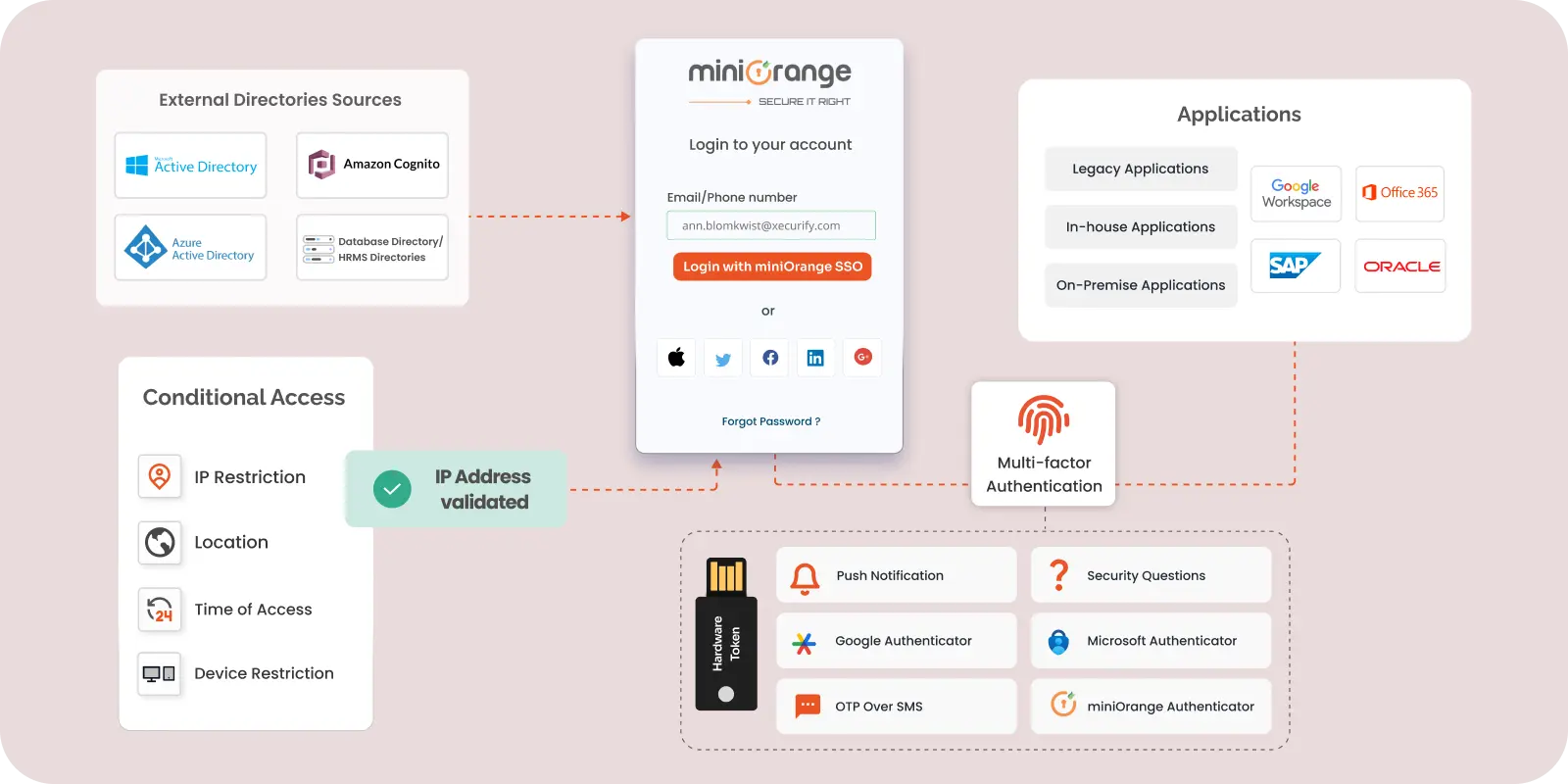

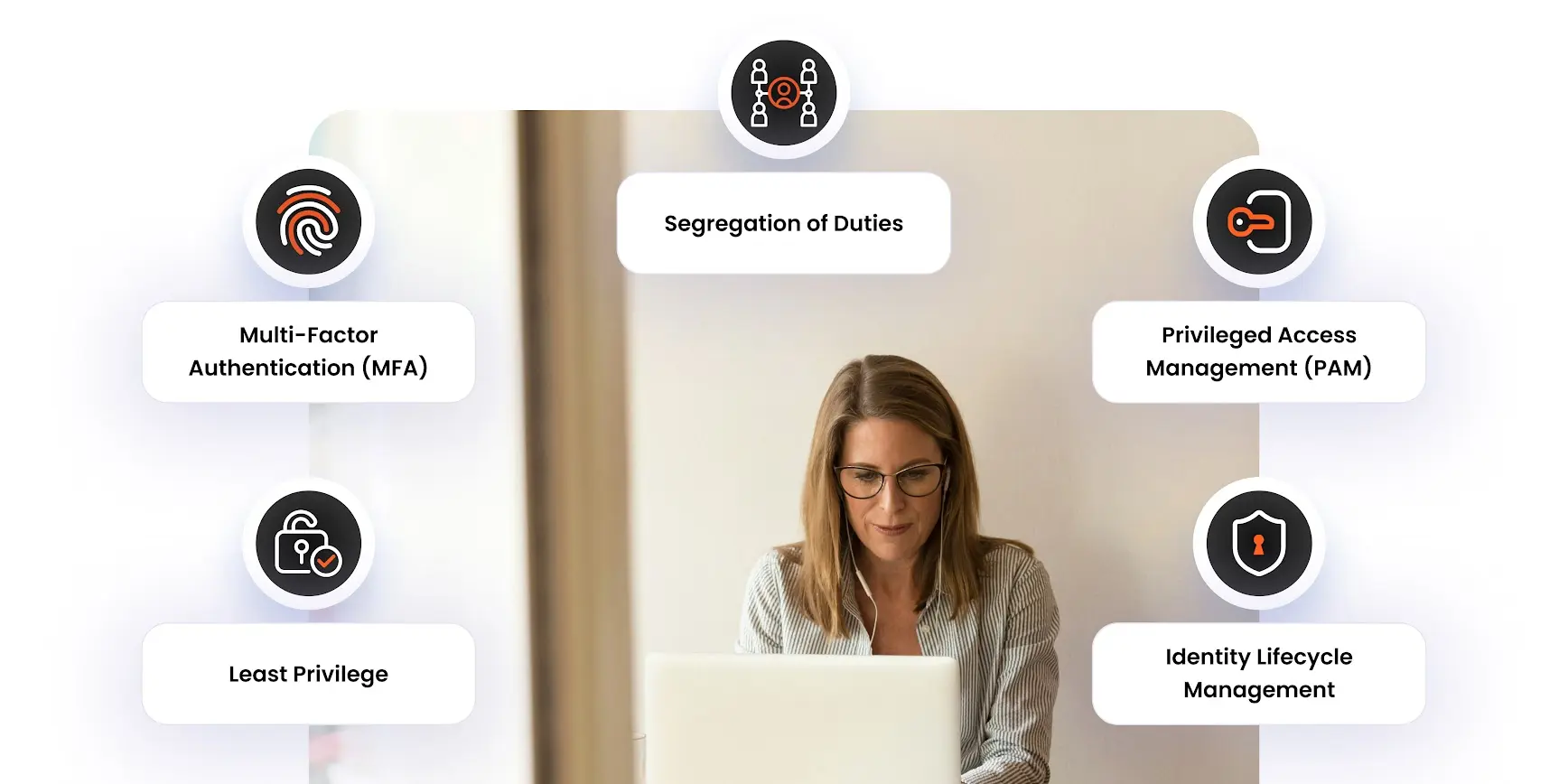

Leave a Comment